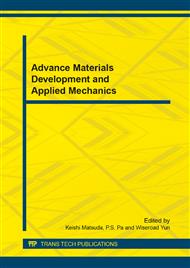[1]
T. Sakamoto, S. Kousaka, K. Uematsu, T. Ishigaki, K. Toda, M. Sato, Synthesis and properties of Na3YSi2O7: Eu3+ phosphor for fluorescent lamp, Phys. Status Solidi C 8 (2011) 2731-2734.
DOI: 10.1002/pssc.201084125
Google Scholar
[2]
S.Q. Yan, Synthesis and luminescence properties of Eu3+ and Sm3+ doped and co-doped BiPO4 powders by a hydrothermal route. J. Mater. Sci: Mater. Electron. 25 (2014) 1868-1872.
DOI: 10.1007/s10854-014-1812-7
Google Scholar
[3]
H.Y. Lin, S.Y. Chu, Concentration Dependence of Multipolar Mechanisms Responsible for Sm3+→Eu3+ Energy Transfer in (Ca0. 97-3x/5. 64Sr0. 03)2. 82(VO4)2: 0. 12Eu3+, xSm3+ Phosphors. ECS J. Solid State Sci. Technol. 2 (2013) 121-125.
Google Scholar
[4]
H.Y. Lin, Y.C. Fang, Energy Transfer Sm3+→Eu3+ in Potential Red Phosphor (Ca, Ba)3(VO4)2: Sm3+, Eu3+ for Use in Organic Solar Cells and White Light-Emitting Diodes. J. Am. Ceram. Soc. 93 (2010) 3850-3856.
DOI: 10.1111/j.1551-2916.2010.03957.x
Google Scholar
[5]
S. Abtmeyer, R. Pazik, R.J. Wiglusz, M. Małecka, G.A. Seisenbaeva, V.G. Kessler, Lanthanum Molybdate Nanoparticles from the Bradley Reaction: Factors Influencing Their Composition, Structure, and Functional Characteristics as Potential Matrixes for Luminescent Phosphors, Inorg. Chem. 53 (2014).
DOI: 10.1021/ic4023486
Google Scholar
[6]
X.J. Geng, Y.W. Tian, Y.J. Chen, L.J. Xiao, Y. Xie, Luminescence properties and energy transfer process of Sm3+-Eu3+ co-doped molybdate red-emitting phosphors by hydrothermal method, Appl. Phys. B 107 (2012) 177-181.
DOI: 10.1007/s00340-012-4916-x
Google Scholar


